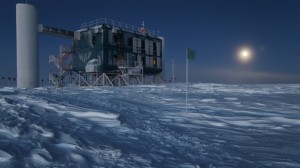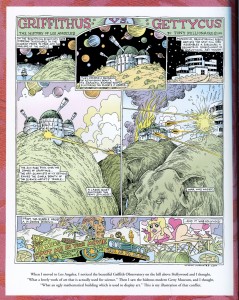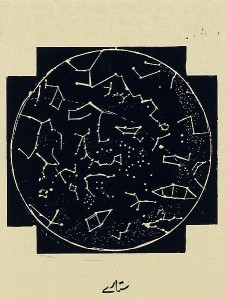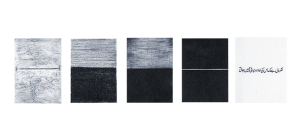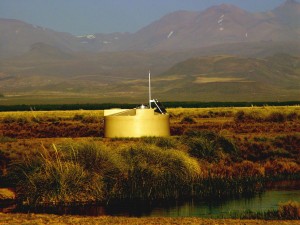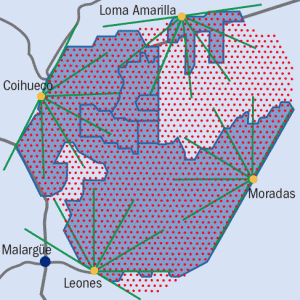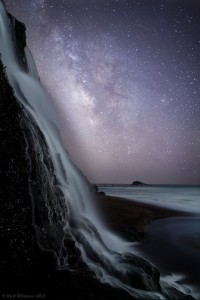The IceCube South Pole Neutrino Observatory is seeking candidates for its “Winterover” positions. If you’ve got wicked UNIX skillz, don’t mind living in isolation, and aren’t particularly attached to sunrise, take a look at the advertisement. If you’d rather just fantasize about working at the South Pole, click on the image above to download various sizes of wallpaper for your computer.
Wallpaper Wednesday (Ice Cube South Pole Neutrino Observatory)
20 02 2013Comments : Comments Off on Wallpaper Wednesday (Ice Cube South Pole Neutrino Observatory)
Categories : News, Observatories, Wallpaper
Griffith Observatory (Tony Millionaire)
18 02 2013Well, I can’t get behind Millionaire’s assessment of the Getty Center, but I like the idea of the two buildings having a laser fight. You can visit the image on Millionaire’s blog.
Comments : Comments Off on Griffith Observatory (Tony Millionaire)
Categories : Ephemera, Griffith Observatory
While You Were Away…
17 02 2013I know, I know. One of the most exciting (and potentially tragic) earth-meteorite encounters in living history and I did nothing to keep you informed. In my defense, I was on the go all day, trying to coax just a few more minutes out that sorry excuse for a battery that powers my iPhone. I just didn’t have the time, mental space, or energy (phone energy) to connect you to videos and analysis. On the other hand, everyone else seems to have had plenty to say about it, so I doubt you missed my commentary.
While I was running around this weekend, supposedly ignoring science, I stopped in at the Guggenheim with a friend. We went for the Gutai exhibition, but I was more taken with the Zarina retrospective. Not only are her prints beautiful and striking as objects, she works on some of my favorite themes—location, memory, space, identity, architecture, environment, mobility, nation. Her personal geography coincided with mine in many places and I was captivated by her ability to pin a spatial memory to paper with ink. And you can see from the image above that her locative work isn’t just about house or city or continent, it’s about the sky and the universe as well.
Zarina: Paper Like Skin is on view at the Guggenheim (New York) through April 21, after which time it moves to the Art Institute of Chicago. In the meantime, you can view some of her work in the online gallery at Luhring Augustine.
Comments : Comments Off on While You Were Away…
Categories : News
Wallpaper Wednesday (Pierre Auger Observatory)
13 02 2013It was surprisingly difficult to locate an image to illustrate today’s post. I was inspired by the March 2013 cover story in Astronomy magazine. Written by Yvette Cendes (follow her on twitter at @whereisyvette), the article outlines the structure and research goals of the Pierre Auger Observatory in Argentina. As you can probably see from the image above, Pierre Auger is a different sort of facility, more akin to the neutrino detectors I discussed last year than South America’s more famous observatory, ESO at Paranal.
I read Cendes’ article a few hours after one of our weekly “Networks of Exchange” colloquia, the focus of which tends to be the materiality of science. This week, we were back on the subject of astronomy and how the tools—and the movement of tools—shape practice. I’m not sure anyone is ready to attribute agency to the instruments, but I feel like we’re moving closer to the default position of architects/designers, which is that objects shape experience and subjectivity in unexpected ways that have little to do with human or social intent.
At any rate, I was inspired by Cendes’ article to think more intently about the construction of scientific spaces. One one hand, it seems as if cosmic-ray detectors are minimally invasive, small-scale structures with low profiles slotted into what Cendes describes as a “truly remote and empty corner of the world.” On the other hand, the observatory is backed by a multi-national contingent of 500 scientists from 55 institutions, which means that regardless of the physical location of the detectors, the exchange of data also requires a robust communications infrastructure with a global reach.
I was completely intrigued by one of the graphics that accompanied the article. It shows the distribution of particle detectors on the pampas northeast of Malargüe. Here is a very similar graphic, published a few years ago in the CERN Courier:
As Cendes explains, we can expect a ultra-high energy cosmic ray (UHECR) strike only once per square-mile of Earth’s surface every 39 years. The distribution of 1,600 water tanks over an area of 3,000 sq. km with a 1-km module maximizes the chances of detecting a UHECR strike. This graphic raises more questions for me than it answers, though. That is, it illustrates quite well the system for detecting UHECRs, but as a historian, I wonder about labor processes behind the land survey, the construction and placement of the tanks, the cadastral maps that must have determined the boundaries of the observatory, the rationalization and flattening of the landscape into an instrument of measure, and the occupation of “nothingness”.
Some of my questions were answered by the “Voices of the Universe” video issued by the observatory. I was intrigued by Paul Mantsch’s assertion that the project transcended nationalist aspirations. As I’ve noted elsewehere, there is a significant number of NASA supporters in the United States who want us to return to the “glory days” of a U.S.-dominant space program. While I wish we as a people would do a better job supporting NASA, projects like the Pierre Auger Observatory demonstrate that “national” science, if it ever existed, is almost extinct.
Okay, this was a rather loosely constructed post (and I didn’t even get to the part about Auger North or ESO’s Deep Space Antenna 3, 30km south of Malargüe), the point of which was just to say: cosmic ray research is very interesting, Cendes’ article lead me to new questions, and you should probably pick up a copy of the March issue of Astronomy.
Comments : Comments Off on Wallpaper Wednesday (Pierre Auger Observatory)
Categories : Instruments, Observatories, Wallpaper
Astropoetry (@Tychogirl)
11 02 2013My most sincere apologies for not drawing your attention to Christine Reuter’s astropoetry before today. Like most good things in life, I discovered Reuter’s work through twitter, where she posts as @tychogirl. Once I’d started reading her poetry, I couldn’t stop. I love the tension she creates between suppressed and revealed text, past and present, science and humanities. Young Ladies’ Astronomy was one of the best poems I read in 2012, partly for its beauty, partly for its subversiveness. Aside from the literary or political merits of Reuter’s work, I find her poems very satisfying as objects (potential objects?). Even in digital form, I can appreciate the layering of media and am continually delighted by her appropriation of original form and illustrations (the globe tethered is a good example of this). This is a poetry I would love to touch.
Comments : Comments Off on Astropoetry (@Tychogirl)
Categories : Ephemera
Wallpaper Wednesday (Peach Mountain Observatory)
6 02 2013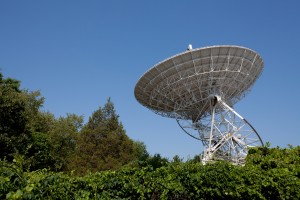
Peach Mountain Observatory. Image credit: James Rotz, Michigan Engineering Communications & Marketing
As a consolation prize to Michigan for their loss to the Now-Number-One-Ranked Hoosiers (in both polls!), today’s post features the University of Michigan 26-meter Radio Telescope at Peach Mountain Observatory. Built in 1958, this dish supplanted an 8.54-meter radio telescope that had been built just three years earlier. If you zoom in with Google Maps (here, I’ve already zoomed for you), you can see the smaller dish at the south of the observatory’s cleared property, with the large dish at the north.
The most interesting thing I discovered while trying to ferret out primary sources documenting the construction of the radio telescope was a stack of technical papers from the 1970s related to the Orbiting Geophysical Observatory (OGO) and Interplanetary Monitoring Platform (IMP-6). For instance:
- Low-Frequency Radio Astronomy Data from the University of Michigan Experiment Aboard IMP-6, 1971-74
- IMP-6 Solar Radio Burst Analysis Final Scientific Report
- Data User’s Notes: OGO-III Experiment Number 18 “Low-Frequency Radio Astronomy”
- Dynamic Spectra of 4-2 MHz Solar Burts: Results from Orbiting Geophysical Observatory III
- OGO-V Radio Burst Analysis
I love that a search for construction documents can lead to random readings on low frequency solar bursts and orbiting observatories.
Right click on the image above to download it or go to Michigan Engineering’s Peach Mountain Observatory set on flickr.
Comments : Comments Off on Wallpaper Wednesday (Peach Mountain Observatory)
Categories : Observatories, Telescopes, Wallpaper
Liquid Light Show (Aurora Australis)
4 02 2013Comments : Comments Off on Liquid Light Show (Aurora Australis)
Categories : Aurora Australis, Video
Aurora Watching at Aurora Sky Station, Abisko, Sweden
4 02 2013Aurora watching at Aurora Sky Station, Abisko, Sweden, January 19, 2013 from Tim Nordström on Vimeo.
Comments : Comments Off on Aurora Watching at Aurora Sky Station, Abisko, Sweden
Categories : Aurora Borealis, Video
Wallpaper Wednesday (Night View of India-Pakistan)
30 01 2013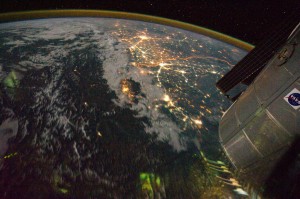
Night view of India-Pakistan borderlands (NASA, International Space Station, 08/21/11). Photo credit: NASA
I don’t write much about my “real” work here, even though this site serves as a repository for ideas and images for future projects. You probably (hopefully) can’t tell, but this blog is actually a textual map of intellectual and geographical connections between observatories and astronomers. The proposal for my next book—assuming I ever finish the one on which I’m working—is hidden in some of my earliest entries.
Today’s image, a view across India and Pakistan from the ISS, is more about my teaching than my research, though. This semester, I’m teaching an undergraduate course on the very broad topic of “urban Asia,” and this week, we’ve been talking about 17-19th-century Lahore. I find myself constantly stumbling over geographical boundaries, saying things like, “in the state we now call Pakistan,” and “India-Pakistan-whatever, at this point, the division is artificial,” and “I know you’re accustomed to thinking of Qandahar as ‘somewhere, over there,’ but at this time, it’s well within the cultural and political world of the Mughals.” In other words, 20th-century borders irritate the heck out of me. It’s difficult to make students see that India and Pakistan under Aurangzeb were same-same. Delhi and Lahore were directly connected by the imperial highway and if you were a Mughal minister, you could just as easily be sent to Kabul as Ujjain.
One of my students asked, “Well, where is Lahore, then?” and the only I answer I had was, “Well…the Panjab, which was less of a state and more of an idea or geography.” As you might expect, that wasn’t a very helpful reply.
This ISS photograph shows that so much of what we think about the world is just a matter of perspective. If you pull back far enough, Delhi and Islamabad can be contained in the same frame of reference.
Click on the image to read NASA’s description of the image and/or to download it in various sizes. You can look at the original image posting here.
Comments : Comments Off on Wallpaper Wednesday (Night View of India-Pakistan)
Categories : ISS, NASA, Wallpaper
Unprogrammed Observing
28 01 2013Rick Whitacre spent eleven hours composing and capturing this image. All of that planning and waiting produced stunning results, but funnily enough, when the photograph popped up on my twitter feed, it reminded me that taking the opposite approach—no planning—also has its benefits. A few weeks ago, I was in California, spending time with my wife’s family in a lovely rental home at the top of a hill overlooking Monterey Bay. Twice I wrapped myself in blankets and sat out on the (cold) metal deck furniture to watch the stars. I can’t remember the last time I sat outside without some sort of agenda to guide me. I go outside to do the #ISSWave, to watch meteor showers, to (infrequently) use one of our telescopes to look at pre-selected targets… I plan a lot, too much.
Sitting outside a few weeks ago, enjoying the best view of the Milky Way I’d had since the last time I was in Monterey, I followed no plan. I didn’t have a star chart (well, my iPhone, but its light messed up my night vision, so I kept in my pocket) or a schedule. Just me, my blankets, and the wind. That’s how I used to observe when I was a kid, staring up at the sky every night without much of a goal other than to eventually fall asleep. I seem to have lost the ability to just watch the stars, I’m too busy trying to fit them into the game plan for my career, or my need for self-improvement, or whatever. Mr. Whitacre’s photograph, for all the work behind it, reminded me that occasionally I should just look at the sky, not study it.
Comments : Comments Off on Unprogrammed Observing
Categories : Observatories
